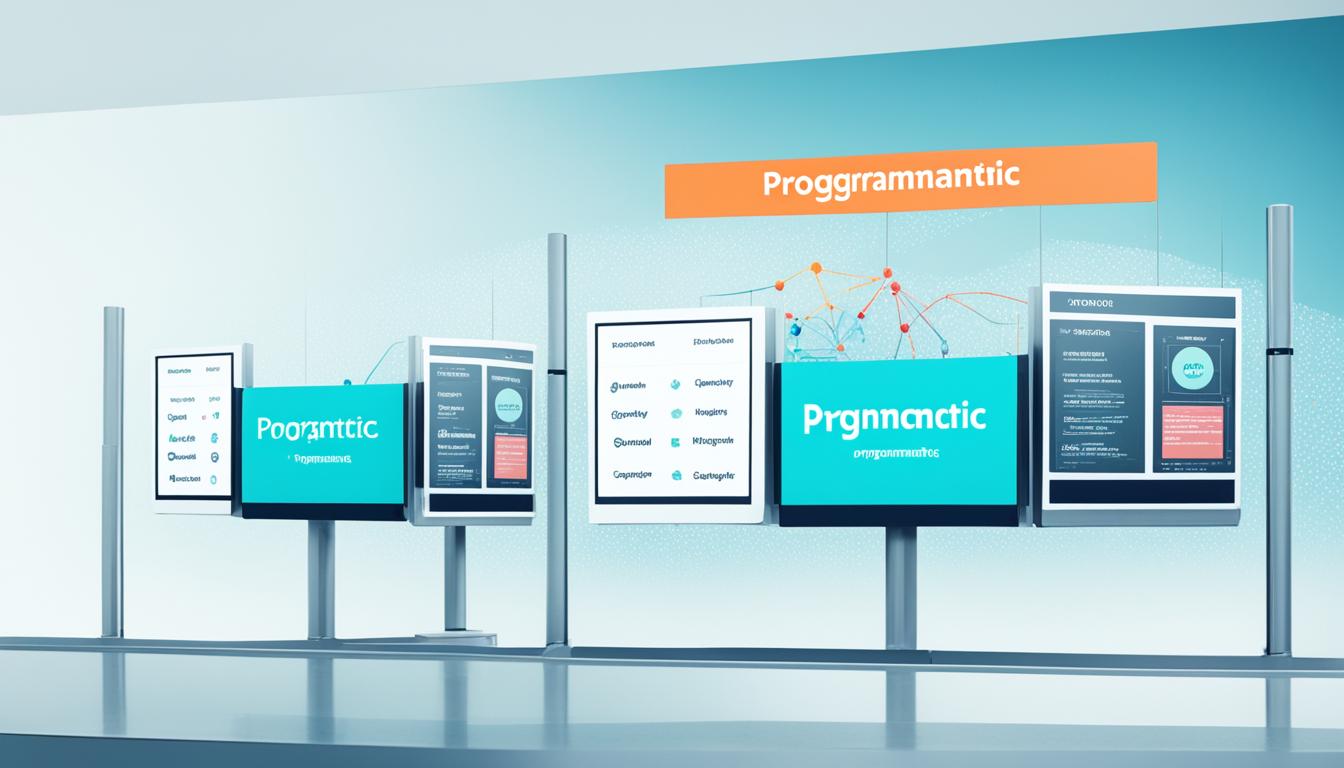Did you know that programmatic advertising is projected to reach nearly $800 billion by 2028? The world of digital marketing is experiencing a significant shift with the growing adoption of programmatic advertising. This spike in interest has piqued the curiosity of many marketers who are eager to understand the differences between programmatic advertising and traditional display ads.
Key Takeaways:
- Programmatic advertising is expected to reach nearly $800 billion by 2028.
- There are significant differences between programmatic advertising and display ads.
- Programmatic advertising utilizes automation and software for ad placement.
- Display ads focus on visual appeal and brand awareness.
- Understanding these differences will help marketers make informed decisions for their digital marketing campaigns.
What are Programmatic Ads?
Programmatic ads are online ads that are purchased and placed using software and automation. This modern approach to ad buying eliminates the need for manual negotiations with human representatives. Instead, programmatic ad buying software allows advertisers to automate the entire process, from purchasing ad space to selecting optimal ad placements and targeting specific audiences.
This automation brings several benefits to advertisers. With programmatic advertising, efficiency is greatly improved as manual tasks are digitized and streamlined. Advertisers can also achieve precise targeting by leveraging data and algorithms to reach the right audience at the right time.
Transparency is another advantage of programmatic ads. Advertisers have access to real-time reporting and optimization, allowing them to make data-driven decisions and adjust their campaigns as needed. This level of transparency also fosters trust between advertisers and publishers.
Furthermore, programmatic ads offer increased reach by providing access to a vast network of websites. Advertisers can leverage automation to reach their target audience across multiple platforms and devices, maximizing their ad’s visibility.
Finally, programmatic ads have proven to deliver improved return on investment (ROI). By leveraging automation and optimization, advertisers can achieve better campaign performance and results.
“Programmatic advertising allows advertisers to automate the entire ad buying process, improving efficiency, targeting, transparency, reach, and ROI.”
The Benefits of Programmatic Ads:
- Efficiency through automation
- Precise targeting based on data and algorithms
- Transparency with real-time reporting and optimization
- Increased reach across multiple platforms and devices
- Improved return on investment (ROI) through optimization
Programmatic ads have revolutionized the world of online advertising, offering advertisers a powerful tool to optimize their campaigns and drive better results.

Comparing Programmatic and Display Ads
When it comes to digital advertising, it’s important to understand the differences between programmatic and display ads. Programmatic advertising refers to the purchase process using automation and software, while display ads pertain to the format of the ad and where it appears on visual-based ads placed on a network of websites.
Programmatic Ads vs. Display Ads:
| Programmatic Ads | Display Ads |
|---|---|
| Automated ad placement | Visual-based ad format |
| Purchased through software and automation | Placed on websites through ad networks |
| Precise targeting and real-time reporting | Offers visual appeal and brand awareness |
| Increased reach and improved ROI | Targeting options and cost-effectiveness |
It’s important to note that programmatic ads can also be display ads and vice versa. However, programmatic ads can be placed both programmatically and manually, while display ads are primarily placed through ad networks.
Programmatic advertising provides several benefits such as efficiency, precise targeting, transparency, real-time reporting and optimization, increased reach, and improved ROI. On the other hand, display ads offer visual appeal, brand awareness, targeting options, cost-effectiveness, and a large reach.
Advantages of Programmatic Advertising
Programmatic advertising offers several advantages for online advertisers. In today’s digital landscape, where online advertising plays a crucial role in reaching target audiences, programmatic advertising has emerged as a powerful and efficient method to maximize campaign success.
1. Efficiency through Automation
One of the key advantages of programmatic advertising is its automation. By leveraging technology and algorithms, programmatic advertising streamlines the ad buying process, eliminating the need for manual negotiations and simplifying campaign management. With programmatic advertising, we can save time and resources, allowing us to focus on other aspects of our marketing strategy.
2. Precise Targeting
Programmatic advertising enables us to target specific audiences based on demographics, interests, location, and even retargeting. By leveraging data and audience insights, we can ensure that our ads are delivered to the right people at the right time, maximizing relevance and engagement. This precise targeting capability enhances the effectiveness of our campaigns and improves overall ROI.
3. Transparency in Advertising Campaigns
Transparency is a crucial aspect of programmatic advertising. With programmatic platforms, we have visibility into how our ads are performing and where they are being displayed. This transparency allows us to make data-driven decisions, optimize campaigns in real-time, and ensure that our ads are being shown in brand-safe environments.
4. Real-Time Reporting and Optimization
Programmatic advertising offers real-time reporting and optimization capabilities. We can access detailed performance data, such as impressions, clicks, conversions, and cost metrics, in real-time. This enables us to identify trends, make data-driven optimizations, and refine our campaigns on the fly, maximizing their effectiveness.
5. Increased Reach
Programmatic advertising provides access to a massive list of websites and platforms. By leveraging programmatic buying, we can reach a broader audience across various digital touchpoints, expanding our brand’s reach and maximizing exposure. This increased reach enables us to connect with potential customers wherever they are online.
6. Improved ROI through Automation and Optimization
With the efficiency and precision offered by programmatic advertising, we can achieve improved return on investment (ROI). By automating the ad buying process and optimizing campaigns based on real-time data, we can ensure that our advertising budget is allocated to the most effective strategies, driving better results and maximizing our ROI.

Programmatic advertising offers numerous advantages for online advertisers. Its efficiency, precise targeting, transparency, real-time reporting and optimization, increased reach, and improved ROI make it a valuable tool in our online advertising strategy.
Advantages of Display Ads
In digital advertising, display ads offer several advantages that make them a valuable tool for marketers. These ads are visually appealing and have the power to capture users’ attention effectively. With their eye-catching design and engaging visuals, display ads create positive impressions and enhance brand awareness.
One of the key strengths of display ads is their ability to reach a wide audience. As users browse various websites, they come across these ads, which increases the exposure and visibility of the brand. Display ads provide an opportunity to showcase products or services to a diverse range of potential customers.
The targeting options available with display ads are another advantage. Marketers can define specific demographics, interests, and other characteristics to reach their desired audience. This targeted approach ensures that the ads are delivered to the right people, increasing the chances of conversions and maximizing the return on investment.
Compared to other advertising methods, display ads are cost-effective. They provide a cost-efficient way to reach a large audience and deliver brand messages effectively. This affordability makes them an attractive choice for businesses of all sizes, whether they are established brands or startups looking to establish their presence.
In summary, the advantages of display ads in digital advertising include:
- Visual appeal and ability to capture users’ attention
- Effective brand awareness and visibility
- Precise targeting options for reaching the desired audience
- Cost-effectiveness compared to other advertising methods
- Wide reach through networks like the Google Display Network
When it comes to digital advertising, display ads play a crucial role in creating an engaging and impactful brand presence. Their visual appeal and targeting capabilities make them a valuable asset for marketers aiming to achieve their advertising goals.

How Programmatic Advertising Works
In the world of digital advertising, programmatic advertising is revolutionizing the way ads are bought and sold. This innovative approach utilizes software and automation to streamline the ad buying process and maximize efficiency. So, how does programmatic advertising actually work?
When a user visits a website, a real-time bidding (RTB) auction takes place behind the scenes. The website’s publisher offers ad space for sale, and advertisers have the opportunity to bid for that ad impression. These auctions happen instantaneously, ensuring that the highest bidder secures the ad placement.
Key to the programmatic advertising process are ad exchanges. Ad exchanges act as marketplaces, connecting publishers and advertisers. Publishers list their available ad space on these exchanges, which advertisers can then access to bid on the impressions they desire. This allows for seamless and efficient ad buying on a large scale.
With programmatic advertising, automation is at the core. Advertisers use software and algorithms to set their bidding parameters, targeting criteria, and budget limits. This automation enables precise ad targeting, ensuring that relevant ads are shown to the right audience at the right time.
Programmatic advertising offers numerous benefits for advertisers, including:
- Precise Targeting: Programmatic ads allow for granular audience targeting based on demographics, interests, behaviors, and more.
- Efficiency: The automated nature of programmatic advertising saves time and resources by eliminating manual negotiations.
- Real-Time Optimization: Advertisers can analyze campaign performance in real-time and make data-driven optimizations to maximize results.
- Increased Reach: Programmatic advertising provides access to a vast network of websites and publishers, expanding advertisers’ reach.
- Improved ROI: By harnessing automation and optimization, programmatic advertising can deliver better returns on ad spend.
In summary, programmatic advertising harnesses the power of automation and ad exchanges to streamline the ad buying process. This method enables precise targeting, improves efficiency, and ultimately drives better results for advertisers.

How Display Advertising Works
Display advertising is a powerful way to reach your target audience and promote your brand. In this section, we will explore how display advertising works, including the role of ad networks and targeting options.
When it comes to display advertising, ad networks play a crucial role. Ad networks connect advertisers with publishers, who own websites where the ads will be displayed. Ad publishers have several options for acquiring ad inventory:
- Contacting site owners directly
- Joining ad networks
- Acquiring ad inventory programmatically
Ad publishers can choose the option that best suits their needs and preferences.
Advertisers, on the other hand, have the opportunity to target their desired audience through display advertising. By using targeting options, advertisers can filter prospective site visitors based on various characteristics, including:
- Demographics
- Behavioral patterns
- Geographical location
- And more
By carefully selecting their targeting options, advertisers can ensure that their ads are seen by the most relevant audience, increasing the chances of engagement and conversions.
Once the ads are live, advertisers can track the effectiveness of their display advertising campaigns through various metrics, including:
- Page views
- Click-through rate (CTR)
- Cost per mille (CPM)
These insights help advertisers evaluate the performance of their campaigns and make informed decisions for optimization.
Now that you understand the inner workings of display advertising, let’s take a closer look at the data-driven world of programmatic advertising in the next section.
Example
“Display advertising allows us to reach a wide audience through strategic ad placement on relevant websites. By utilizing ad networks and employing precise targeting options, we can ensure that our ads are seen by the right people, leading to higher engagement and conversions.”
Comparing Display Advertising and Programmatic Advertising
| Display Advertising | Programmatic Advertising |
|---|---|
| Placement of ads on websites | Automated purchase and placement of ads |
| Targeting options | Precise targeting based on various parameters |
| Manual ad inventory acquisition | Automated ad inventory acquisition through software |
| Metrics tracked: Page views, CTR, CPM | Metrics tracked: Impressions, conversions, ROI |

Programmatic Advertising
Programmatic advertising is an automated method of buying and placing ads. It uses sophisticated algorithms and data analysis to target specific audiences, ensuring that ads are displayed to the right people at the right time. Programmatic advertising is highly efficient, allowing advertisers to maximize their ad spend and achieve better ROI. It also provides detailed real-time reporting and optimization for continuous campaign improvement.
Direct Display Advertising
Direct display advertising involves direct placement of ads on specific websites or within closed ad networks. This method requires advertisers to negotiate directly with publishers or network partners to secure ad space. While it may offer more control over ad placement, direct display advertising typically has a more limited reach compared to programmatic advertising. It is a more traditional approach and does not offer the same level of automation and optimization capabilities.
When it comes to choosing between programmatic and direct display advertising, it is important to consider your advertising goals, budget, and target audience. Programmatic advertising offers greater efficiency, precise targeting, and scalability, making it ideal for large-scale campaigns and reaching a broader audience. On the other hand, direct display advertising can be effective for niche markets or when specific websites align closely with your brand.
The Growth of Programmatic Advertising
Programmatic advertising is experiencing significant growth, with ad spend projected to reach new heights. In 2023, global programmatic advertising spending nearly hit $550 billion, and experts anticipate it to climb close to $800 billion by 2028. The digital ad spending landscape is evolving, and programmatic advertising is emerging as the dominant method.
Rapid Growth in Programmatic Video Ad Spending
Programmatic video ad spending is a key driver of the overall growth in programmatic advertising. In 2023, programmatic video ad spending amounted to $74 billion, and it is expected to surge to $96 billion by 2025. As video content becomes increasingly popular and platforms like YouTube and social media embrace programmatic advertising, this upward trend is likely to continue.
Programmatic advertising offers advertisers numerous advantages, including efficiency, precise targeting, transparency, real-time reporting and optimization, increased reach, and improved return on investment (ROI). Its ability to automate the ad buying process and optimize campaigns in real-time allows advertisers to maximize their ad spend and achieve better results.
With the continuous growth of programmatic advertising and the proven effectiveness of its strategies, advertisers are increasingly shifting their digital ad spending towards this method. By leveraging programmatic advertising, businesses can reach their target audiences more efficiently and drive better campaign performance.

| Year | Programmatic Advertising Spending (in billions) |
|---|---|
| 2023 | $550 |
| 2025 | $700 |
| 2028 | $800 |
Conclusion
In the world of digital marketing, programmatic advertising and display ads are two distinct approaches that offer unique advantages for advertisers. Programmatic advertising allows for efficient and precise targeting, transparency in reporting and optimization, and increased reach, ultimately leading to improved return on investment (ROI).
On the other hand, display ads excel in visual appeal, creating brand awareness, providing various targeting options, and offering cost-effective solutions with a wide reach. Both programmatic advertising and display ads play integral roles in the success of digital marketing campaigns.
Understanding the differences between these two strategies is crucial for marketers to make informed decisions about their digital advertising strategies.
By considering the strengths of programmatic advertising and display ads, marketers can develop comprehensive campaigns that optimize efficiency, target the right audience, and effectively promote their brands in the competitive digital landscape.
FAQ
What are programmatic ads?
Programmatic ads are online ads that are purchased and placed using software and automation. This differs from manual methods of negotiating with human representatives. Programmatic ad buying software allows advertisers to automate the process of purchasing ad space, selecting ideal locations for ads, targeting specific audiences, and more.
What are display ads?
Display ads are visual-based digital ads that come in various formats such as banner ads, video ads, and native advertising. They can contain images, videos, text, and audio. Display ads are placed on websites through networks like the Google Display Network.
How do programmatic advertising and display ads differ?
Programmatic and display ads refer to two different aspects of digital advertising. Programmatic refers to the purchase process using automation and software, while display refers to the format of the ad and where it appears on visual-based ads placed on a network of websites. Programmatic ads can be display ads, and display ads can be programmatic, but they can also be placed manually.
What are the advantages of programmatic advertising?
Programmatic advertising offers benefits such as efficiency through automation, precise targeting based on demographics, interests, location, and retargeting, transparency in advertising campaigns, real-time reporting and optimization, increased reach through access to a massive list of websites, and improved ROI through automation and optimization.
What are the advantages of display ads?
Display ads have advantages such as visual appeal and brand awareness, targeting options, cost-effectiveness compared to other advertising methods, and a large reach through networks like the Google Display Network.
How does programmatic advertising work?
Programmatic advertising works through the use of software and automation. When a user visits a website, the publisher auctions off the ad impression, and advertisers place their bids in real-time. The highest bidder wins the auction and their ad is displayed on the website. Programmatic advertising uses ad exchanges, where publishers offer ad space to be bought programmatically, and advertisers enter automated bids. This process allows for accurate ad placement and efficient ad buying.
How does display advertising work?
Display advertising works by placing ads on websites through ad networks. Ad publishers can contact site owners directly, join ad networks, or acquire ad inventory programmatically. Advertisers choose targeting options to filter prospective site visitors based on demographic, behavioral, geographical, and other characteristics. Results from page views, click-through rate, and cost per mille help advertisers determine the effectiveness of their display advertising campaigns.
What is the difference between programmatic and direct display advertising?
The difference between programmatic and direct display advertising lies in the method of ad placement and the reach of ad inventory. Programmatic advertising uses automation and multiple ad exchanges, offering a broader audience reach and precise targeting options. Direct display advertising takes place within closed ad networks, limiting its reach. Programmatic advertising also allows for the placement of native ads that blend seamlessly into content, while direct display ads are more traditional in their appearance.
What is the growth potential of programmatic advertising?
Programmatic advertising is on the rise, with ad spend expected to reach significant levels. In 2023, programmatic advertising reached nearly $550 billion worldwide and is projected to reach close to $800 billion by 2028. Programmatic video ad spending is also growing rapidly, with an expected increase from $74 billion in 2023 to $96 billion in 2025. Programmatic advertising is becoming the dominant method of digital advertising, with its efficiency and effectiveness driving its growth.
How should I choose between programmatic advertising and display ads?
Programmatic advertising and display ads are two different approaches to online advertising, each with its own advantages. Programmatic advertising offers benefits such as efficiency, precise targeting, transparency, real-time reporting and optimization, increased reach, and improved ROI. Display ads have advantages such as visual appeal, brand awareness, targeting options, cost-effectiveness, and a large reach. Understanding the differences between programmatic advertising and display ads can help marketers choose the most effective strategy for their digital marketing campaigns.










